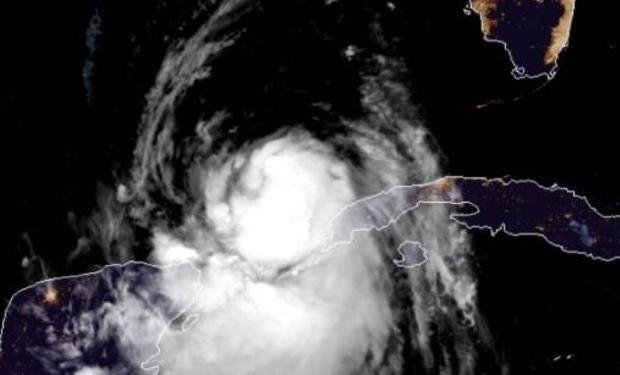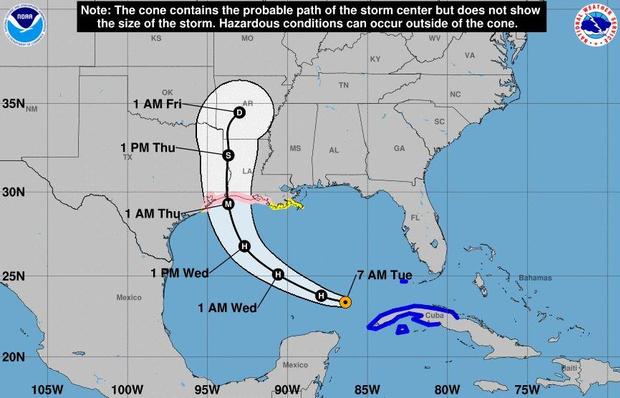Laura became a hurricane Tuesday after moving into the Gulf of Mexico, gathering strength on a path to hit the U.S. coast as a major storm that could swamp entire towns.
The storm killed at least 11 people in the Dominican Republic and Haiti, where it knocked out power and caused flooding in the two nations that share the island of Hispaniola. The deaths reportedly included a 10-year-old girl whose home was hit by a tree and a mother and young son who were crushed by a collapsing wall.
As of 8:15 a.m. ET, Laura was about 145 miles northwest of the western tip of Cuba and 625 miles southeast of Lake Charles, Louisiana, according to the National Hurricane Center. The storm was moving west-northwest at 17 mph with maximum sustained winds of 75 mph, making it a Category 1 hurricane.
The hurricane center in Miami forecast that Laura will move over the Gulf of Mexico on Tuesday, then approach the upper Texas and southwest Louisiana coasts Wednesday night and move inland near those areas Thursday.
The toasty waters of the Gulf of Mexico serve as fuel for storms, and forecasters predict Laura will rapidly strengthen ahead of the expected Wednesday landfall. The question is just how much.
“The question,” said CBS News weather producer David Parkinson, “is does it (become) a Category 3 or even a 4. I can’t rule out the storm being a major hurricane. … As the storm organizes Tuesday, we could watch the pressure drop rapidly. Rapid intensification should be able to take place … all the way up to landfall.
“We are still targeting a 10 p.m.-6 a.m. window for landfall Wednesday into Thursday.”
“Right now, about 17.5 million people are likely to feel the worst impacts of the storm, which include a storm surge higher than a one story home (up to 11 feet) as well as a foot of rain.”
The storm is moving toward the coast after another storm, Marco, all but petered out after making landfall Monday evening.
Louisiana Governor John Bel Edwards told a news briefing, “Our sights are on Laura now. It has the potential to be a major hurricane.”
In Port Arthur Texas, Mayor Thurman Bartie warned that unless the forecast changes and pushes Laura’s landfall farther east, he will ask the city’s more than 54,000 residents to evacuate. “If you decide to stay, you’re staying on your own,” Bartie said.
Officials in Houston asked residents to prepare supplies in case they lose power for a few days or need to evacuate homes along the coast.
Across the border in Louisiana’s Cameron Parish, residents were preparing as well. Mandatory evacuation orders were issued for much of the parish, where officials said seawater pushed inland by the storm could submerge small coastal communities. In other coastal areas residents moved possessions to higher ground, filled sandbags and in one case, moved pews and other items from a church that has flooded before.
“Right now we’re right in the bullseye but that could change,” said Jeff Benoit, owner of B&O Kitchen and Grocery, a restaurant and Cajun food store in the southwest Louisiana city of Lake Charles. He was busy Monday, keeping track of what local officials were saying and preparing to shut the small business down if need be.
“It’s just a matter of putting up some meats, making sure that’s secure, best I can, anyway, and get the heck out of here,” Benoit said.
State emergencies were declared in Louisiana and Mississippi, and shelters were being opened with cots set farther apart, among other measures designed to curb coronavirus infections.
Edwards encouraged evacuees to stay with relatives or in hotels, but officials said they made virus-related preparations at state shelters in case they’re needed.
More workers were being evacuated from production platforms in the Gulf of Mexico in anticipation of Laura’s arrival, reducing offshore oil and gas production to less than one-fifth the normal activity. The Interior Department said Monday that 281 platforms had been evacuated by around midday. That’s nearly half of those normally with workers on site.
The department estimated that 82% of oil production and 57% of natural gas production in the Gulf has been shut down.
Much of the region was also put under a storm surge watch. Forecasters warned of storm surge as high as 11 feet in western Louisiana. Add to that 4 to 10 inches of rain expected when Laura arrives starting late Wednesday.
The punch from back-to-back storms comes just days before the August 29 anniversary of Hurricane Katrina, which breached the levees in New Orleans, flattened much of the Mississippi coast and killed as many as 1,800 people in 2005. Then a little less than a month later came Hurricane Rita which struck southwest Louisiana on September 24 as a Category 3 storm.
Source: Read Full Article




